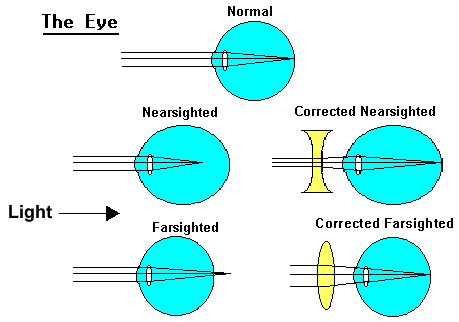Neuroscience For Kids
Do You Wear Glasses? Here's Why! 
 Have you ever seen this "eye
chart" before? It is smaller than the real version of the chart that is
used to test how well you can see. It was first developed in 1863. If
you have 20/20 vision, it means that at a distance of 20 feet, you can
read a certain line (labeled 20) on the chart and that your vision is
normal. If you can only see the top line clearly (the one labeled 200),
then you have 20/200 vision. This means that you must be 20 feet from the
chart to see what most people can see at 200 feet. By the way, if
someone's vision is 20/200 or less in their better eye with use of the
best eyeglass lens to correct their eyesight, then they are legally
blind.
Have you ever seen this "eye
chart" before? It is smaller than the real version of the chart that is
used to test how well you can see. It was first developed in 1863. If
you have 20/20 vision, it means that at a distance of 20 feet, you can
read a certain line (labeled 20) on the chart and that your vision is
normal. If you can only see the top line clearly (the one labeled 200),
then you have 20/200 vision. This means that you must be 20 feet from the
chart to see what most people can see at 200 feet. By the way, if
someone's vision is 20/200 or less in their better eye with use of the
best eyeglass lens to correct their eyesight, then they are legally
blind.
 People wear glasses for
several reasons. People who have "fuzzy" vision when they look at distant
objects are called nearsighted (myopic). In these people, the image is
focused in front of the retina. The lens of
glasses needed to correct vision in nearsighted people is concave.
People who need glasses for reading and who have "fuzzy" vision for
objects close to them are called farsighted (hyperopia). In farsighted
people, objects are focused behind the retina. The lens of glasses needed
to correct vision in farsighted people is convex. Astigmatism is another
reason that you might have to wear glasses.
People wear glasses for
several reasons. People who have "fuzzy" vision when they look at distant
objects are called nearsighted (myopic). In these people, the image is
focused in front of the retina. The lens of
glasses needed to correct vision in nearsighted people is concave.
People who need glasses for reading and who have "fuzzy" vision for
objects close to them are called farsighted (hyperopia). In farsighted
people, objects are focused behind the retina. The lens of glasses needed
to correct vision in farsighted people is convex. Astigmatism is another
reason that you might have to wear glasses.

Did you know? |
Approximately 160 million people in the US wear glasses or contact lenses. (Source: Walker, T.C. and Miller, R.K., 2001 Health Care Business Market Research Handbook, Fifth Edition, Norcross (GA): Richard K. Miller and Associates, Inc., 2001.) |
![]()
They said it! |
"Spectacles. I don't use them. All I ask is a
large, fair type, a strong daylight or gas-light, and one yard of focal
distance, and my eyes are as good as ever." --- Oliver Wendell Holmes, The Autocrat of the Breakfast Table, 1858 |
More information:
Copyright © 1996-2011, Eric H. Chudler, University of Washington
